Business Intelligence, Knowledge Management, and SunPower Report
VerifiedAdded on 2020/02/24
|11
|2247
|46
Report
AI Summary
This report provides an in-depth analysis of business intelligence (BI) and knowledge management (KM), with a specific focus on its application within the SunPower Corporation. The report is structured into five key sections, commencing with an exploration of fundamental concepts related to BI, decision support systems (DSS), and KM. The subsequent sections delve into the practical application of BI tools and approaches at the enterprise level, evaluating organizational requirements to ascertain the effectiveness of BI and KM strategies. Furthermore, the report identifies and analyzes knowledge domains within the organization for knowledge mapping purposes and culminates in an examination of the pivotal aspects of a KM strategy within a business context. The report emphasizes the importance of integrating BI and KM to enhance decision-making processes, foster knowledge sharing, and ultimately, establish a sustainable competitive advantage. It covers the use of various BI tools, data mining, DSS, and knowledge-based systems, as well as feasibility studies, resource specifications, and project limitations, providing a comprehensive overview of the subject matter.
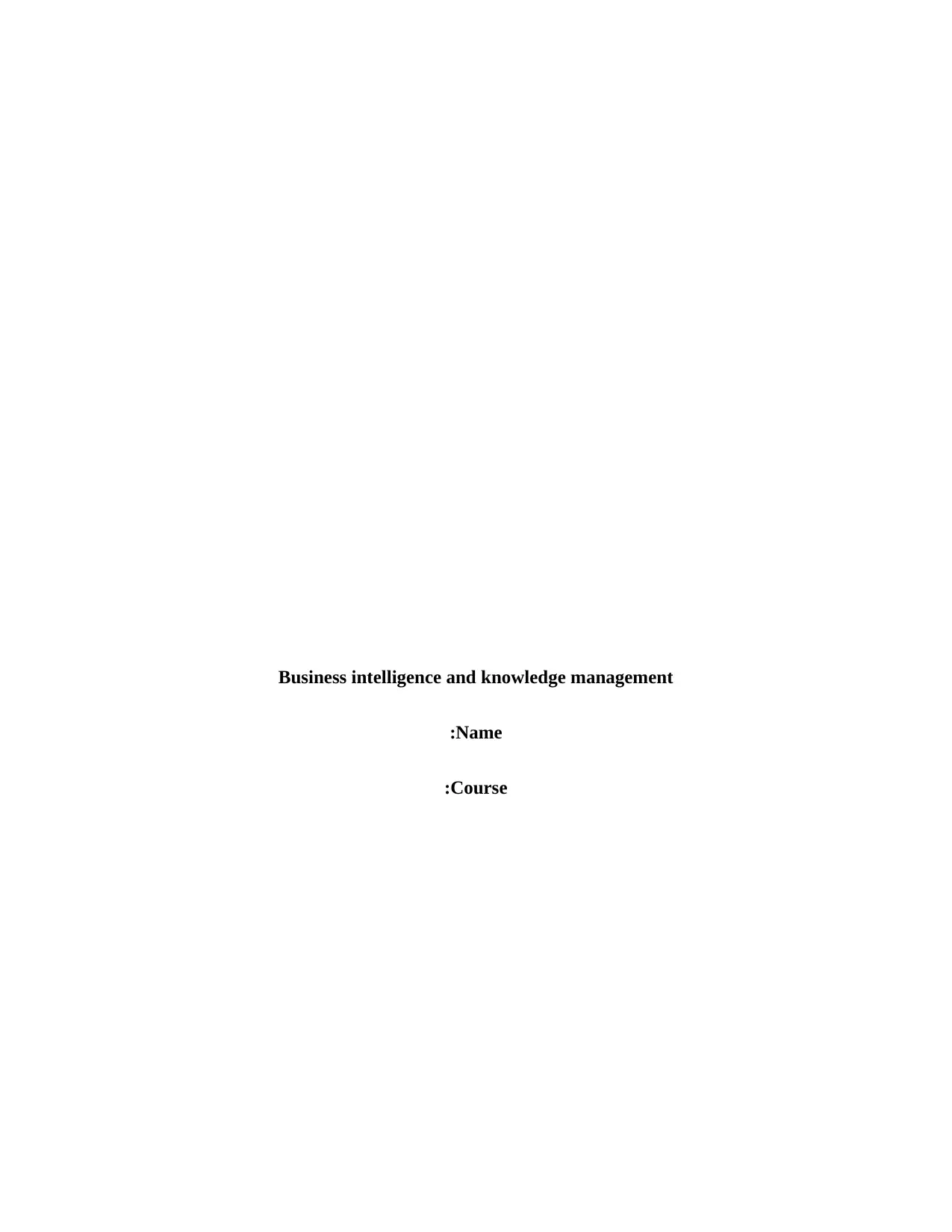
Business intelligence and knowledge management
Name:
Course:
Name:
Course:
Paraphrase This Document
Need a fresh take? Get an instant paraphrase of this document with our AI Paraphraser
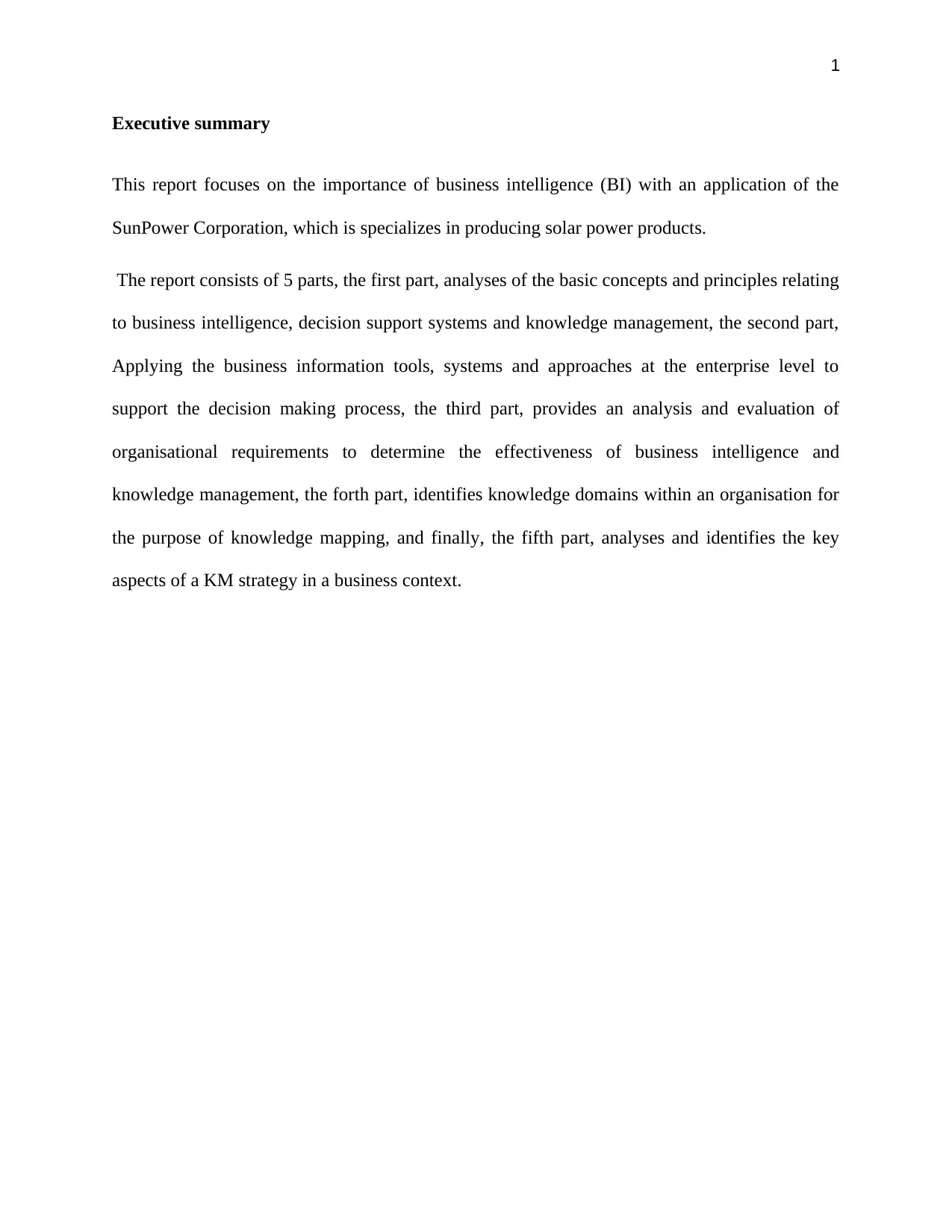
1
Executive summary
This report focuses on the importance of business intelligence (BI) with an application of the
SunPower Corporation, which is specializes in producing solar power products.
The report consists of 5 parts, the first part, analyses of the basic concepts and principles relating
to business intelligence, decision support systems and knowledge management, the second part,
Applying the business information tools, systems and approaches at the enterprise level to
support the decision making process, the third part, provides an analysis and evaluation of
organisational requirements to determine the effectiveness of business intelligence and
knowledge management, the forth part, identifies knowledge domains within an organisation for
the purpose of knowledge mapping, and finally, the fifth part, analyses and identifies the key
aspects of a KM strategy in a business context.
Executive summary
This report focuses on the importance of business intelligence (BI) with an application of the
SunPower Corporation, which is specializes in producing solar power products.
The report consists of 5 parts, the first part, analyses of the basic concepts and principles relating
to business intelligence, decision support systems and knowledge management, the second part,
Applying the business information tools, systems and approaches at the enterprise level to
support the decision making process, the third part, provides an analysis and evaluation of
organisational requirements to determine the effectiveness of business intelligence and
knowledge management, the forth part, identifies knowledge domains within an organisation for
the purpose of knowledge mapping, and finally, the fifth part, analyses and identifies the key
aspects of a KM strategy in a business context.
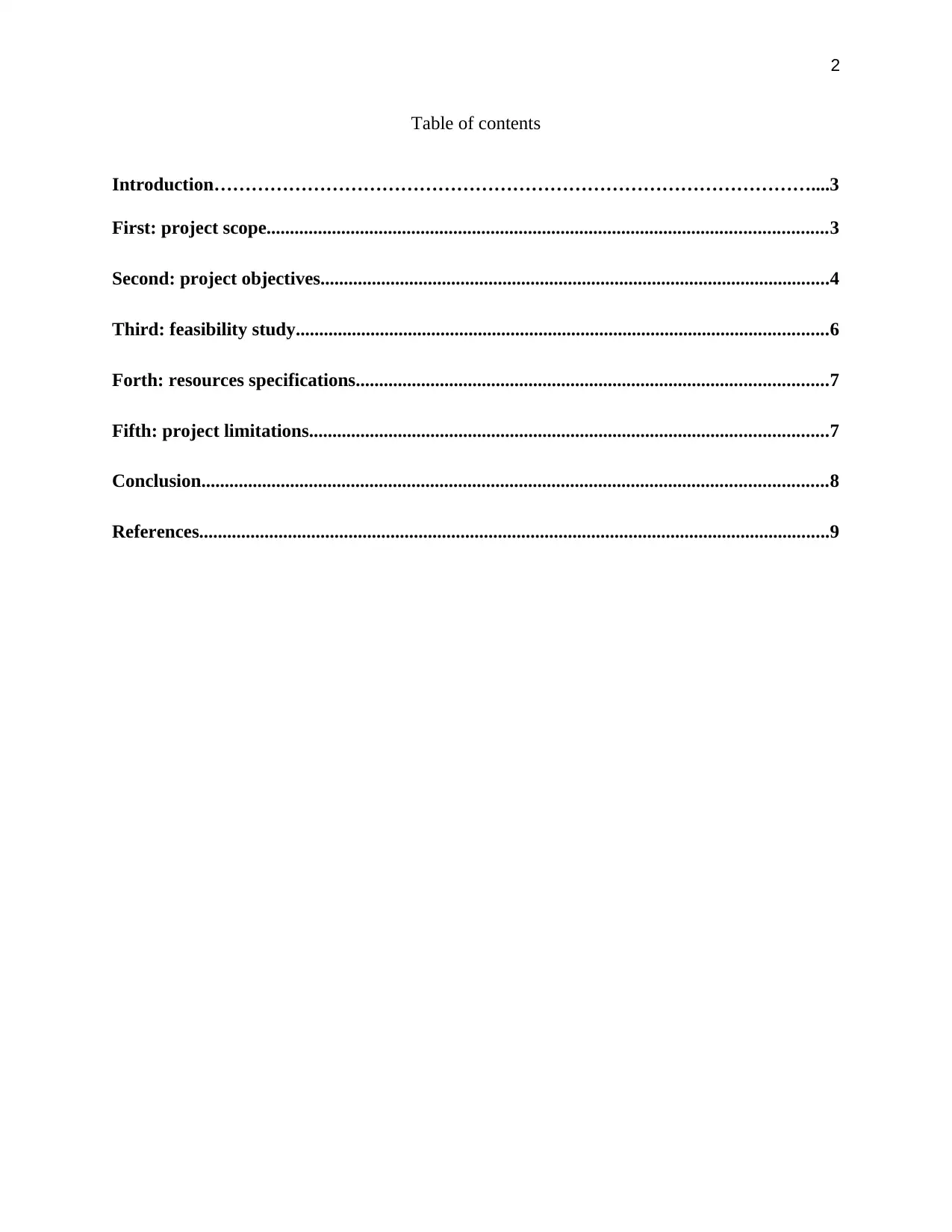
2
Table of contents
Introduction……………………………………………………………………………………....3
First: project scope........................................................................................................................3
Second: project objectives.............................................................................................................4
Third: feasibility study..................................................................................................................6
Forth: resources specifications.....................................................................................................7
Fifth: project limitations...............................................................................................................7
Conclusion......................................................................................................................................8
References.......................................................................................................................................9
Table of contents
Introduction……………………………………………………………………………………....3
First: project scope........................................................................................................................3
Second: project objectives.............................................................................................................4
Third: feasibility study..................................................................................................................6
Forth: resources specifications.....................................................................................................7
Fifth: project limitations...............................................................................................................7
Conclusion......................................................................................................................................8
References.......................................................................................................................................9
⊘ This is a preview!⊘
Do you want full access?
Subscribe today to unlock all pages.

Trusted by 1+ million students worldwide
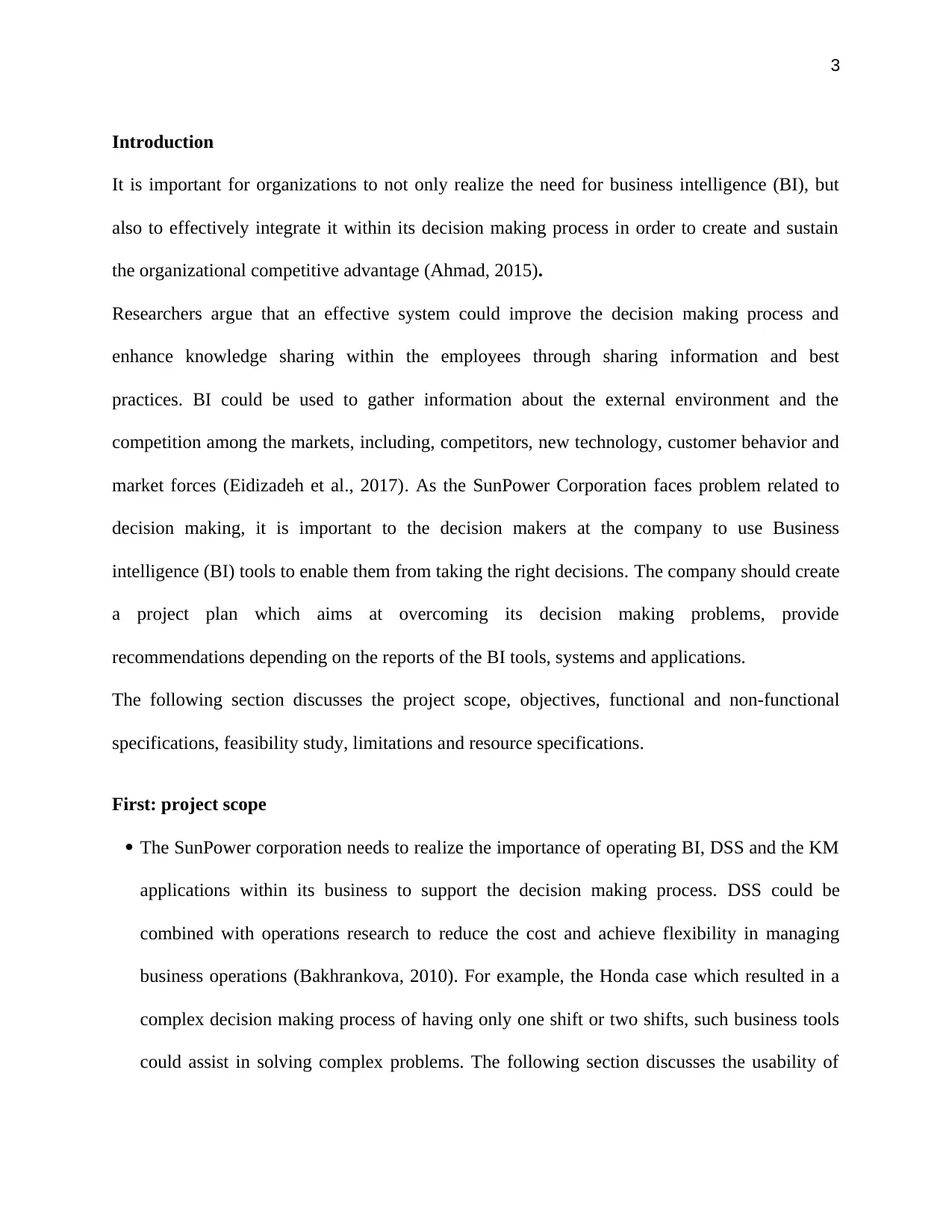
3
Introduction
It is important for organizations to not only realize the need for business intelligence (BI), but
also to effectively integrate it within its decision making process in order to create and sustain
the organizational competitive advantage (Ahmad, 2015).
Researchers argue that an effective system could improve the decision making process and
enhance knowledge sharing within the employees through sharing information and best
practices. BI could be used to gather information about the external environment and the
competition among the markets, including, competitors, new technology, customer behavior and
market forces (Eidizadeh et al., 2017). As the SunPower Corporation faces problem related to
decision making, it is important to the decision makers at the company to use Business
intelligence (BI) tools to enable them from taking the right decisions. The company should create
a project plan which aims at overcoming its decision making problems, provide
recommendations depending on the reports of the BI tools, systems and applications.
The following section discusses the project scope, objectives, functional and non-functional
specifications, feasibility study, limitations and resource specifications.
First: project scope
The SunPower corporation needs to realize the importance of operating BI, DSS and the KM
applications within its business to support the decision making process. DSS could be
combined with operations research to reduce the cost and achieve flexibility in managing
business operations (Bakhrankova, 2010). For example, the Honda case which resulted in a
complex decision making process of having only one shift or two shifts, such business tools
could assist in solving complex problems. The following section discusses the usability of
Introduction
It is important for organizations to not only realize the need for business intelligence (BI), but
also to effectively integrate it within its decision making process in order to create and sustain
the organizational competitive advantage (Ahmad, 2015).
Researchers argue that an effective system could improve the decision making process and
enhance knowledge sharing within the employees through sharing information and best
practices. BI could be used to gather information about the external environment and the
competition among the markets, including, competitors, new technology, customer behavior and
market forces (Eidizadeh et al., 2017). As the SunPower Corporation faces problem related to
decision making, it is important to the decision makers at the company to use Business
intelligence (BI) tools to enable them from taking the right decisions. The company should create
a project plan which aims at overcoming its decision making problems, provide
recommendations depending on the reports of the BI tools, systems and applications.
The following section discusses the project scope, objectives, functional and non-functional
specifications, feasibility study, limitations and resource specifications.
First: project scope
The SunPower corporation needs to realize the importance of operating BI, DSS and the KM
applications within its business to support the decision making process. DSS could be
combined with operations research to reduce the cost and achieve flexibility in managing
business operations (Bakhrankova, 2010). For example, the Honda case which resulted in a
complex decision making process of having only one shift or two shifts, such business tools
could assist in solving complex problems. The following section discusses the usability of
Paraphrase This Document
Need a fresh take? Get an instant paraphrase of this document with our AI Paraphraser
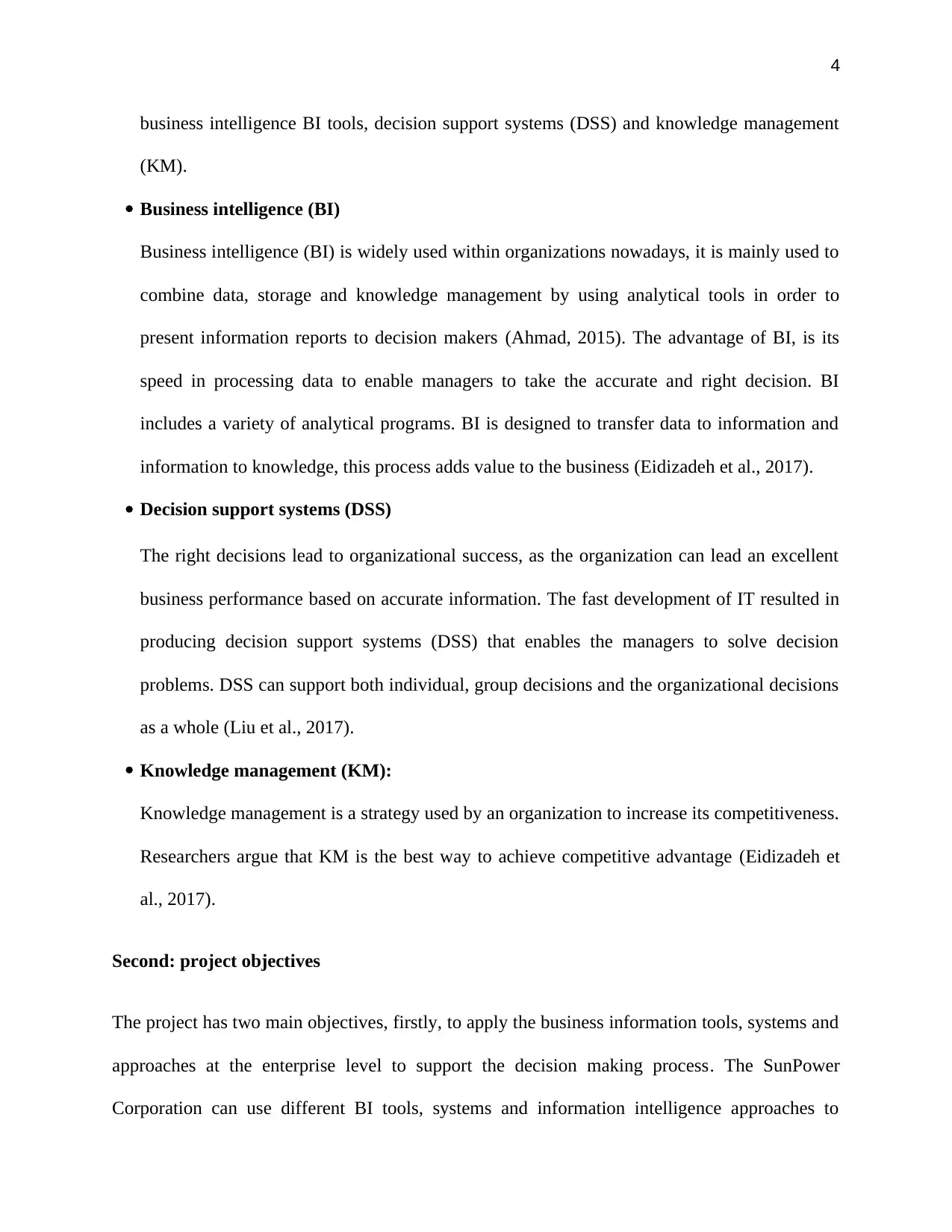
4
business intelligence BI tools, decision support systems (DSS) and knowledge management
(KM).
Business intelligence (BI)
Business intelligence (BI) is widely used within organizations nowadays, it is mainly used to
combine data, storage and knowledge management by using analytical tools in order to
present information reports to decision makers (Ahmad, 2015). The advantage of BI, is its
speed in processing data to enable managers to take the accurate and right decision. BI
includes a variety of analytical programs. BI is designed to transfer data to information and
information to knowledge, this process adds value to the business (Eidizadeh et al., 2017).
Decision support systems (DSS)
The right decisions lead to organizational success, as the organization can lead an excellent
business performance based on accurate information. The fast development of IT resulted in
producing decision support systems (DSS) that enables the managers to solve decision
problems. DSS can support both individual, group decisions and the organizational decisions
as a whole (Liu et al., 2017).
Knowledge management (KM):
Knowledge management is a strategy used by an organization to increase its competitiveness.
Researchers argue that KM is the best way to achieve competitive advantage (Eidizadeh et
al., 2017).
Second: project objectives
The project has two main objectives, firstly, to apply the business information tools, systems and
approaches at the enterprise level to support the decision making process. The SunPower
Corporation can use different BI tools, systems and information intelligence approaches to
business intelligence BI tools, decision support systems (DSS) and knowledge management
(KM).
Business intelligence (BI)
Business intelligence (BI) is widely used within organizations nowadays, it is mainly used to
combine data, storage and knowledge management by using analytical tools in order to
present information reports to decision makers (Ahmad, 2015). The advantage of BI, is its
speed in processing data to enable managers to take the accurate and right decision. BI
includes a variety of analytical programs. BI is designed to transfer data to information and
information to knowledge, this process adds value to the business (Eidizadeh et al., 2017).
Decision support systems (DSS)
The right decisions lead to organizational success, as the organization can lead an excellent
business performance based on accurate information. The fast development of IT resulted in
producing decision support systems (DSS) that enables the managers to solve decision
problems. DSS can support both individual, group decisions and the organizational decisions
as a whole (Liu et al., 2017).
Knowledge management (KM):
Knowledge management is a strategy used by an organization to increase its competitiveness.
Researchers argue that KM is the best way to achieve competitive advantage (Eidizadeh et
al., 2017).
Second: project objectives
The project has two main objectives, firstly, to apply the business information tools, systems and
approaches at the enterprise level to support the decision making process. The SunPower
Corporation can use different BI tools, systems and information intelligence approaches to
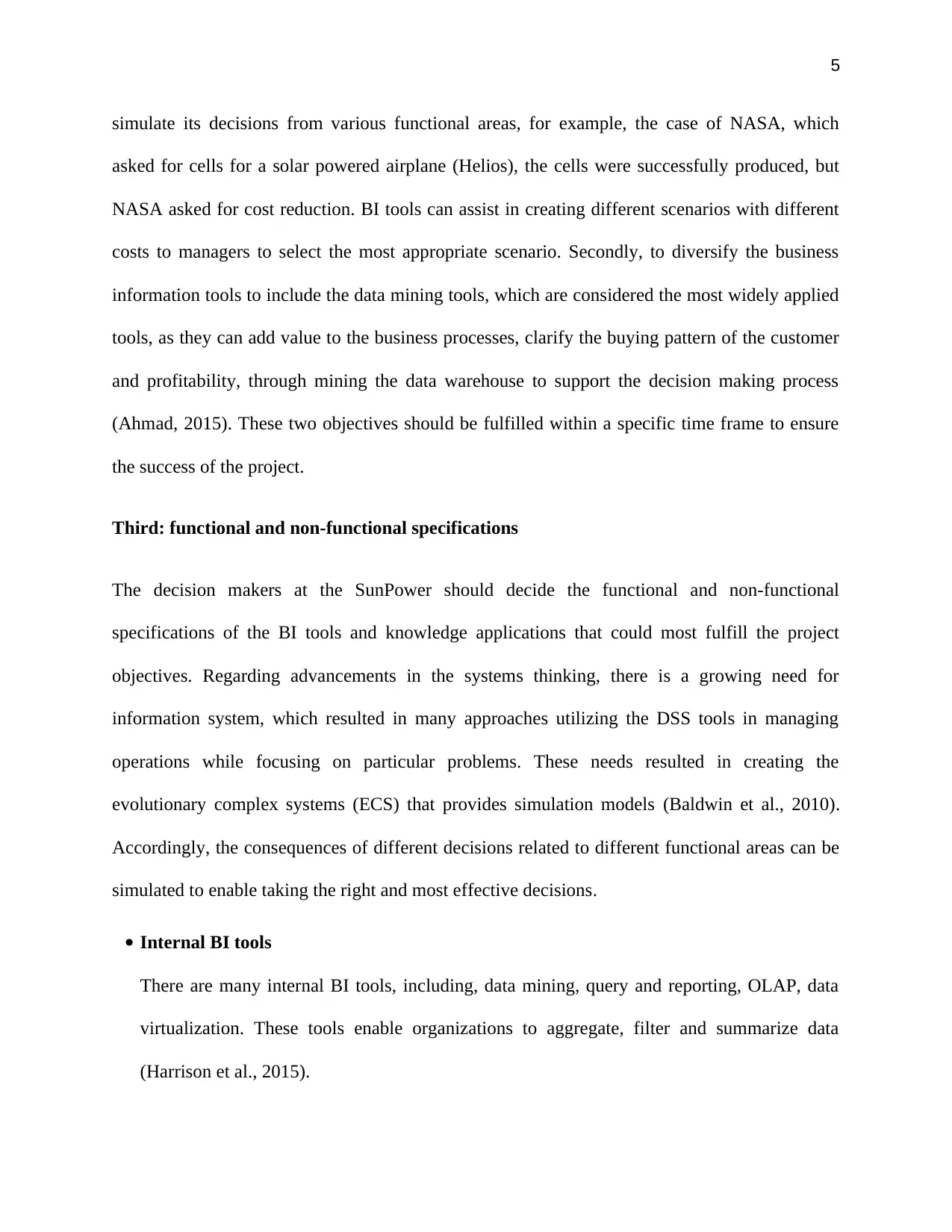
5
simulate its decisions from various functional areas, for example, the case of NASA, which
asked for cells for a solar powered airplane (Helios), the cells were successfully produced, but
NASA asked for cost reduction. BI tools can assist in creating different scenarios with different
costs to managers to select the most appropriate scenario. Secondly, to diversify the business
information tools to include the data mining tools, which are considered the most widely applied
tools, as they can add value to the business processes, clarify the buying pattern of the customer
and profitability, through mining the data warehouse to support the decision making process
(Ahmad, 2015). These two objectives should be fulfilled within a specific time frame to ensure
the success of the project.
Third: functional and non-functional specifications
The decision makers at the SunPower should decide the functional and non-functional
specifications of the BI tools and knowledge applications that could most fulfill the project
objectives. Regarding advancements in the systems thinking, there is a growing need for
information system, which resulted in many approaches utilizing the DSS tools in managing
operations while focusing on particular problems. These needs resulted in creating the
evolutionary complex systems (ECS) that provides simulation models (Baldwin et al., 2010).
Accordingly, the consequences of different decisions related to different functional areas can be
simulated to enable taking the right and most effective decisions.
Internal BI tools
There are many internal BI tools, including, data mining, query and reporting, OLAP, data
virtualization. These tools enable organizations to aggregate, filter and summarize data
(Harrison et al., 2015).
simulate its decisions from various functional areas, for example, the case of NASA, which
asked for cells for a solar powered airplane (Helios), the cells were successfully produced, but
NASA asked for cost reduction. BI tools can assist in creating different scenarios with different
costs to managers to select the most appropriate scenario. Secondly, to diversify the business
information tools to include the data mining tools, which are considered the most widely applied
tools, as they can add value to the business processes, clarify the buying pattern of the customer
and profitability, through mining the data warehouse to support the decision making process
(Ahmad, 2015). These two objectives should be fulfilled within a specific time frame to ensure
the success of the project.
Third: functional and non-functional specifications
The decision makers at the SunPower should decide the functional and non-functional
specifications of the BI tools and knowledge applications that could most fulfill the project
objectives. Regarding advancements in the systems thinking, there is a growing need for
information system, which resulted in many approaches utilizing the DSS tools in managing
operations while focusing on particular problems. These needs resulted in creating the
evolutionary complex systems (ECS) that provides simulation models (Baldwin et al., 2010).
Accordingly, the consequences of different decisions related to different functional areas can be
simulated to enable taking the right and most effective decisions.
Internal BI tools
There are many internal BI tools, including, data mining, query and reporting, OLAP, data
virtualization. These tools enable organizations to aggregate, filter and summarize data
(Harrison et al., 2015).
⊘ This is a preview!⊘
Do you want full access?
Subscribe today to unlock all pages.

Trusted by 1+ million students worldwide
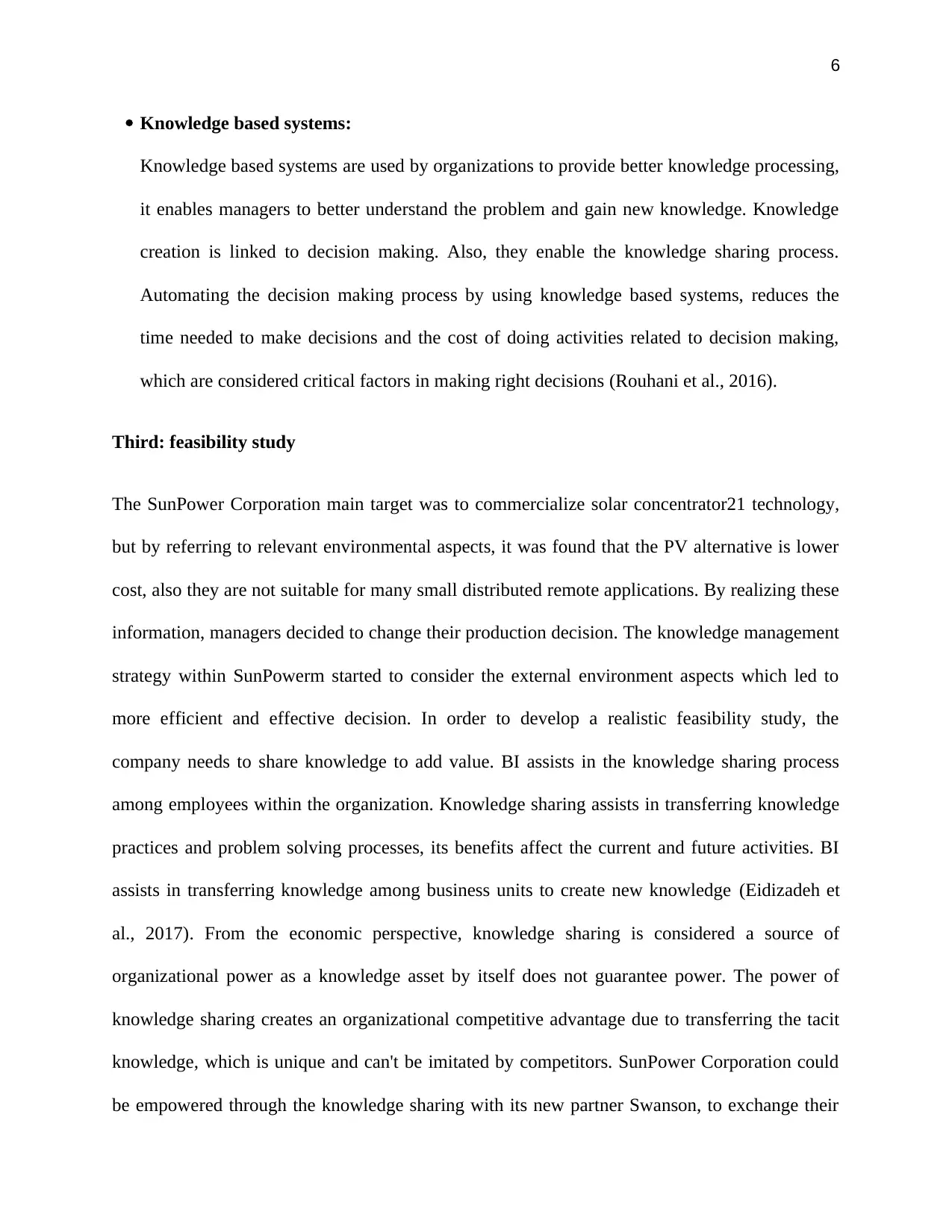
6
Knowledge based systems:
Knowledge based systems are used by organizations to provide better knowledge processing,
it enables managers to better understand the problem and gain new knowledge. Knowledge
creation is linked to decision making. Also, they enable the knowledge sharing process.
Automating the decision making process by using knowledge based systems, reduces the
time needed to make decisions and the cost of doing activities related to decision making,
which are considered critical factors in making right decisions (Rouhani et al., 2016).
Third: feasibility study
The SunPower Corporation main target was to commercialize solar concentrator21 technology,
but by referring to relevant environmental aspects, it was found that the PV alternative is lower
cost, also they are not suitable for many small distributed remote applications. By realizing these
information, managers decided to change their production decision. The knowledge management
strategy within SunPowerm started to consider the external environment aspects which led to
more efficient and effective decision. In order to develop a realistic feasibility study, the
company needs to share knowledge to add value. BI assists in the knowledge sharing process
among employees within the organization. Knowledge sharing assists in transferring knowledge
practices and problem solving processes, its benefits affect the current and future activities. BI
assists in transferring knowledge among business units to create new knowledge (Eidizadeh et
al., 2017). From the economic perspective, knowledge sharing is considered a source of
organizational power as a knowledge asset by itself does not guarantee power. The power of
knowledge sharing creates an organizational competitive advantage due to transferring the tacit
knowledge, which is unique and can't be imitated by competitors. SunPower Corporation could
be empowered through the knowledge sharing with its new partner Swanson, to exchange their
Knowledge based systems:
Knowledge based systems are used by organizations to provide better knowledge processing,
it enables managers to better understand the problem and gain new knowledge. Knowledge
creation is linked to decision making. Also, they enable the knowledge sharing process.
Automating the decision making process by using knowledge based systems, reduces the
time needed to make decisions and the cost of doing activities related to decision making,
which are considered critical factors in making right decisions (Rouhani et al., 2016).
Third: feasibility study
The SunPower Corporation main target was to commercialize solar concentrator21 technology,
but by referring to relevant environmental aspects, it was found that the PV alternative is lower
cost, also they are not suitable for many small distributed remote applications. By realizing these
information, managers decided to change their production decision. The knowledge management
strategy within SunPowerm started to consider the external environment aspects which led to
more efficient and effective decision. In order to develop a realistic feasibility study, the
company needs to share knowledge to add value. BI assists in the knowledge sharing process
among employees within the organization. Knowledge sharing assists in transferring knowledge
practices and problem solving processes, its benefits affect the current and future activities. BI
assists in transferring knowledge among business units to create new knowledge (Eidizadeh et
al., 2017). From the economic perspective, knowledge sharing is considered a source of
organizational power as a knowledge asset by itself does not guarantee power. The power of
knowledge sharing creates an organizational competitive advantage due to transferring the tacit
knowledge, which is unique and can't be imitated by competitors. SunPower Corporation could
be empowered through the knowledge sharing with its new partner Swanson, to exchange their
Paraphrase This Document
Need a fresh take? Get an instant paraphrase of this document with our AI Paraphraser
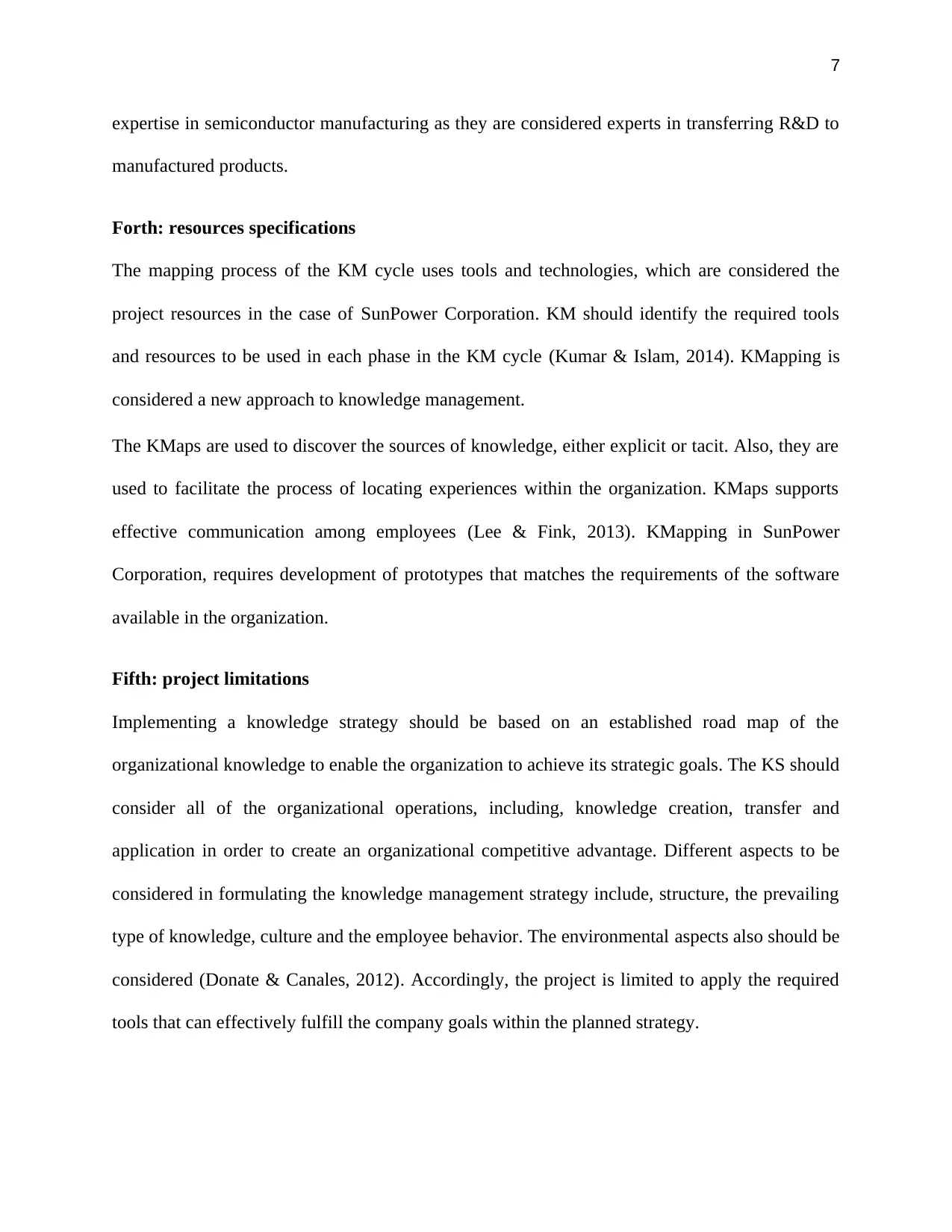
7
expertise in semiconductor manufacturing as they are considered experts in transferring R&D to
manufactured products.
Forth: resources specifications
The mapping process of the KM cycle uses tools and technologies, which are considered the
project resources in the case of SunPower Corporation. KM should identify the required tools
and resources to be used in each phase in the KM cycle (Kumar & Islam, 2014). KMapping is
considered a new approach to knowledge management.
The KMaps are used to discover the sources of knowledge, either explicit or tacit. Also, they are
used to facilitate the process of locating experiences within the organization. KMaps supports
effective communication among employees (Lee & Fink, 2013). KMapping in SunPower
Corporation, requires development of prototypes that matches the requirements of the software
available in the organization.
Fifth: project limitations
Implementing a knowledge strategy should be based on an established road map of the
organizational knowledge to enable the organization to achieve its strategic goals. The KS should
consider all of the organizational operations, including, knowledge creation, transfer and
application in order to create an organizational competitive advantage. Different aspects to be
considered in formulating the knowledge management strategy include, structure, the prevailing
type of knowledge, culture and the employee behavior. The environmental aspects also should be
considered (Donate & Canales, 2012). Accordingly, the project is limited to apply the required
tools that can effectively fulfill the company goals within the planned strategy.
expertise in semiconductor manufacturing as they are considered experts in transferring R&D to
manufactured products.
Forth: resources specifications
The mapping process of the KM cycle uses tools and technologies, which are considered the
project resources in the case of SunPower Corporation. KM should identify the required tools
and resources to be used in each phase in the KM cycle (Kumar & Islam, 2014). KMapping is
considered a new approach to knowledge management.
The KMaps are used to discover the sources of knowledge, either explicit or tacit. Also, they are
used to facilitate the process of locating experiences within the organization. KMaps supports
effective communication among employees (Lee & Fink, 2013). KMapping in SunPower
Corporation, requires development of prototypes that matches the requirements of the software
available in the organization.
Fifth: project limitations
Implementing a knowledge strategy should be based on an established road map of the
organizational knowledge to enable the organization to achieve its strategic goals. The KS should
consider all of the organizational operations, including, knowledge creation, transfer and
application in order to create an organizational competitive advantage. Different aspects to be
considered in formulating the knowledge management strategy include, structure, the prevailing
type of knowledge, culture and the employee behavior. The environmental aspects also should be
considered (Donate & Canales, 2012). Accordingly, the project is limited to apply the required
tools that can effectively fulfill the company goals within the planned strategy.
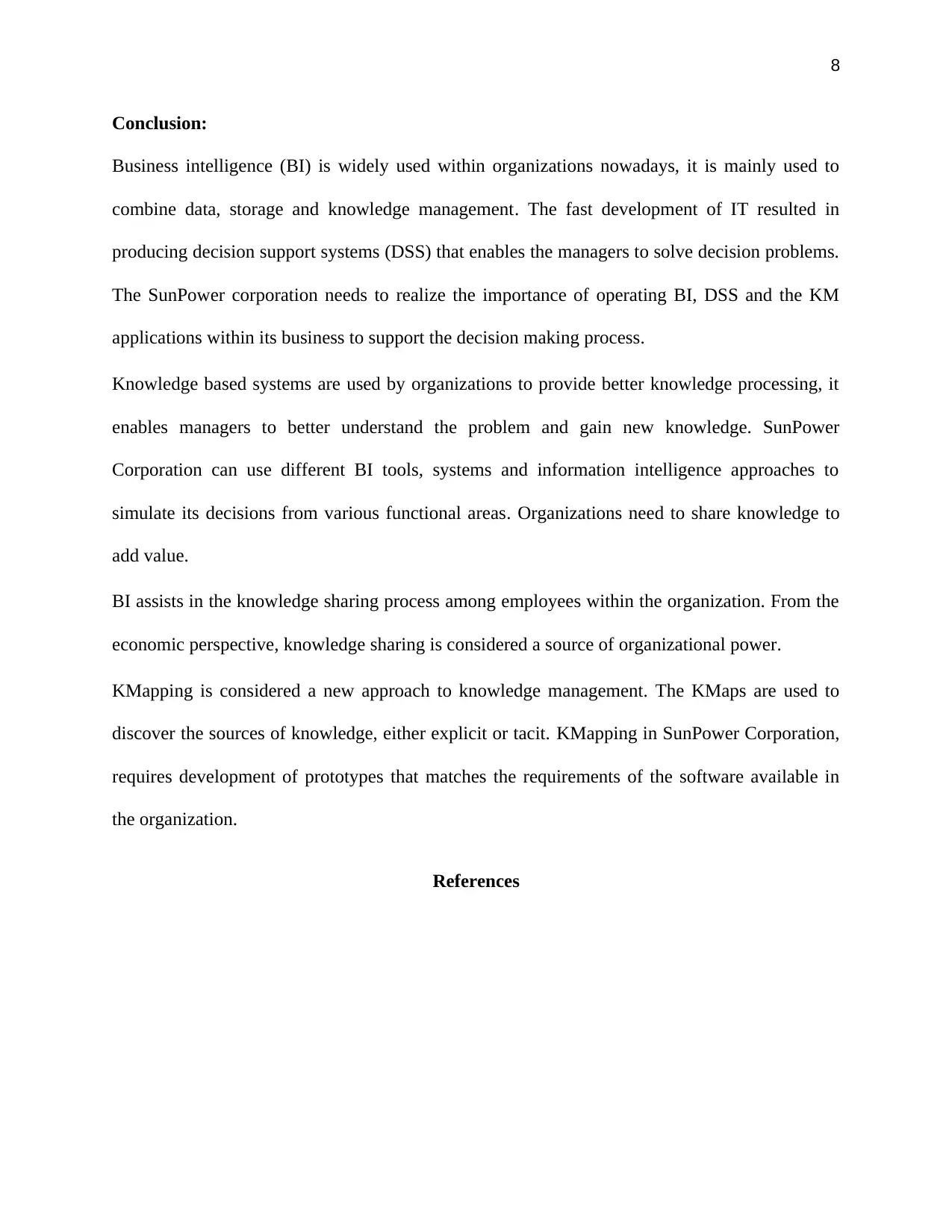
8
Conclusion:
Business intelligence (BI) is widely used within organizations nowadays, it is mainly used to
combine data, storage and knowledge management. The fast development of IT resulted in
producing decision support systems (DSS) that enables the managers to solve decision problems.
The SunPower corporation needs to realize the importance of operating BI, DSS and the KM
applications within its business to support the decision making process.
Knowledge based systems are used by organizations to provide better knowledge processing, it
enables managers to better understand the problem and gain new knowledge. SunPower
Corporation can use different BI tools, systems and information intelligence approaches to
simulate its decisions from various functional areas. Organizations need to share knowledge to
add value.
BI assists in the knowledge sharing process among employees within the organization. From the
economic perspective, knowledge sharing is considered a source of organizational power.
KMapping is considered a new approach to knowledge management. The KMaps are used to
discover the sources of knowledge, either explicit or tacit. KMapping in SunPower Corporation,
requires development of prototypes that matches the requirements of the software available in
the organization.
References
Conclusion:
Business intelligence (BI) is widely used within organizations nowadays, it is mainly used to
combine data, storage and knowledge management. The fast development of IT resulted in
producing decision support systems (DSS) that enables the managers to solve decision problems.
The SunPower corporation needs to realize the importance of operating BI, DSS and the KM
applications within its business to support the decision making process.
Knowledge based systems are used by organizations to provide better knowledge processing, it
enables managers to better understand the problem and gain new knowledge. SunPower
Corporation can use different BI tools, systems and information intelligence approaches to
simulate its decisions from various functional areas. Organizations need to share knowledge to
add value.
BI assists in the knowledge sharing process among employees within the organization. From the
economic perspective, knowledge sharing is considered a source of organizational power.
KMapping is considered a new approach to knowledge management. The KMaps are used to
discover the sources of knowledge, either explicit or tacit. KMapping in SunPower Corporation,
requires development of prototypes that matches the requirements of the software available in
the organization.
References
⊘ This is a preview!⊘
Do you want full access?
Subscribe today to unlock all pages.

Trusted by 1+ million students worldwide
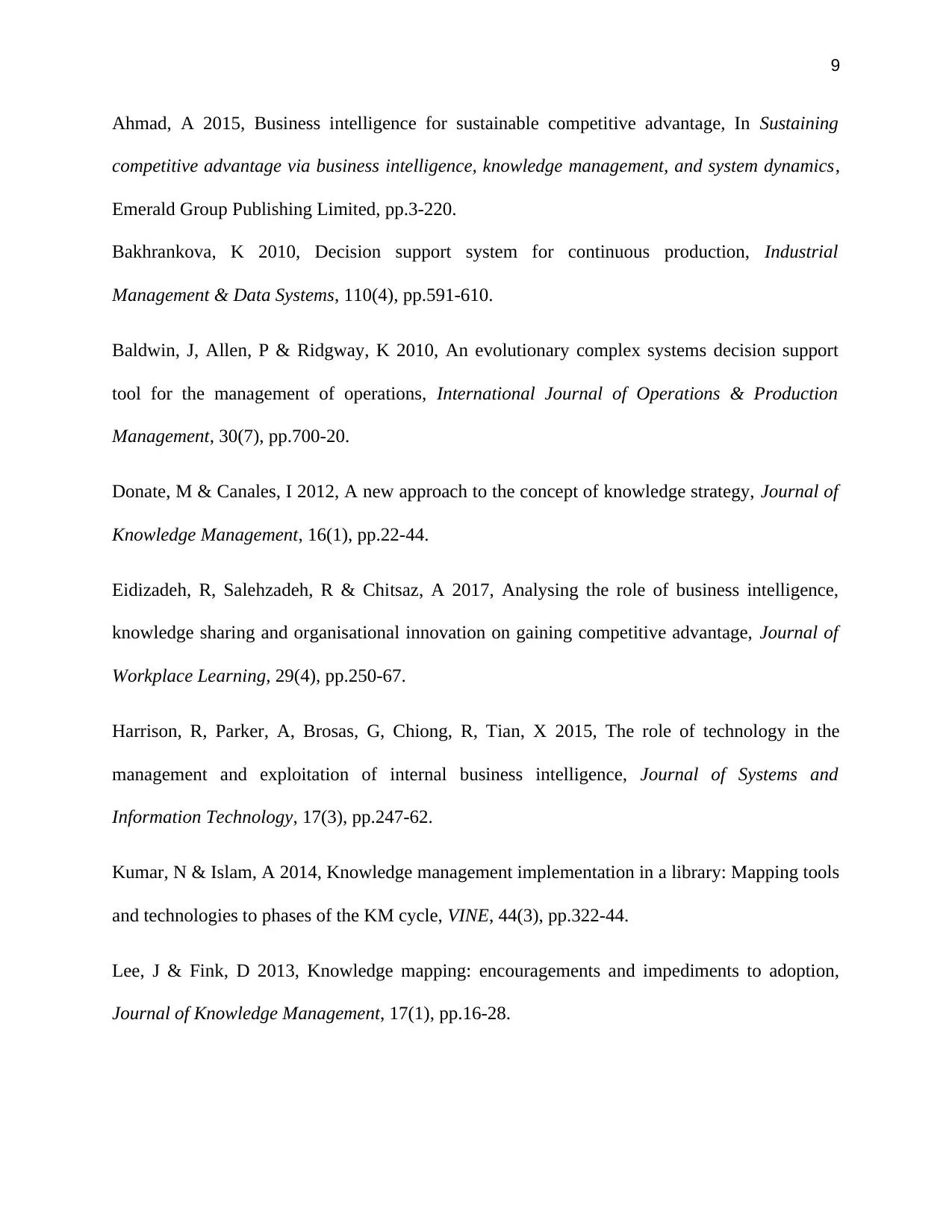
9
Ahmad, A 2015, Business intelligence for sustainable competitive advantage, In Sustaining
competitive advantage via business intelligence, knowledge management, and system dynamics,
Emerald Group Publishing Limited, pp.3-220.
Bakhrankova, K 2010, Decision support system for continuous production, Industrial
Management & Data Systems, 110(4), pp.591-610.
Baldwin, J, Allen, P & Ridgway, K 2010, An evolutionary complex systems decision support
tool for the management of operations, International Journal of Operations & Production
Management, 30(7), pp.700-20.
Donate, M & Canales, I 2012, A new approach to the concept of knowledge strategy, Journal of
Knowledge Management, 16(1), pp.22-44.
Eidizadeh, R, Salehzadeh, R & Chitsaz, A 2017, Analysing the role of business intelligence,
knowledge sharing and organisational innovation on gaining competitive advantage, Journal of
Workplace Learning, 29(4), pp.250-67.
Harrison, R, Parker, A, Brosas, G, Chiong, R, Tian, X 2015, The role of technology in the
management and exploitation of internal business intelligence, Journal of Systems and
Information Technology, 17(3), pp.247-62.
Kumar, N & Islam, A 2014, Knowledge management implementation in a library: Mapping tools
and technologies to phases of the KM cycle, VINE, 44(3), pp.322-44.
Lee, J & Fink, D 2013, Knowledge mapping: encouragements and impediments to adoption,
Journal of Knowledge Management, 17(1), pp.16-28.
Ahmad, A 2015, Business intelligence for sustainable competitive advantage, In Sustaining
competitive advantage via business intelligence, knowledge management, and system dynamics,
Emerald Group Publishing Limited, pp.3-220.
Bakhrankova, K 2010, Decision support system for continuous production, Industrial
Management & Data Systems, 110(4), pp.591-610.
Baldwin, J, Allen, P & Ridgway, K 2010, An evolutionary complex systems decision support
tool for the management of operations, International Journal of Operations & Production
Management, 30(7), pp.700-20.
Donate, M & Canales, I 2012, A new approach to the concept of knowledge strategy, Journal of
Knowledge Management, 16(1), pp.22-44.
Eidizadeh, R, Salehzadeh, R & Chitsaz, A 2017, Analysing the role of business intelligence,
knowledge sharing and organisational innovation on gaining competitive advantage, Journal of
Workplace Learning, 29(4), pp.250-67.
Harrison, R, Parker, A, Brosas, G, Chiong, R, Tian, X 2015, The role of technology in the
management and exploitation of internal business intelligence, Journal of Systems and
Information Technology, 17(3), pp.247-62.
Kumar, N & Islam, A 2014, Knowledge management implementation in a library: Mapping tools
and technologies to phases of the KM cycle, VINE, 44(3), pp.322-44.
Lee, J & Fink, D 2013, Knowledge mapping: encouragements and impediments to adoption,
Journal of Knowledge Management, 17(1), pp.16-28.
Paraphrase This Document
Need a fresh take? Get an instant paraphrase of this document with our AI Paraphraser
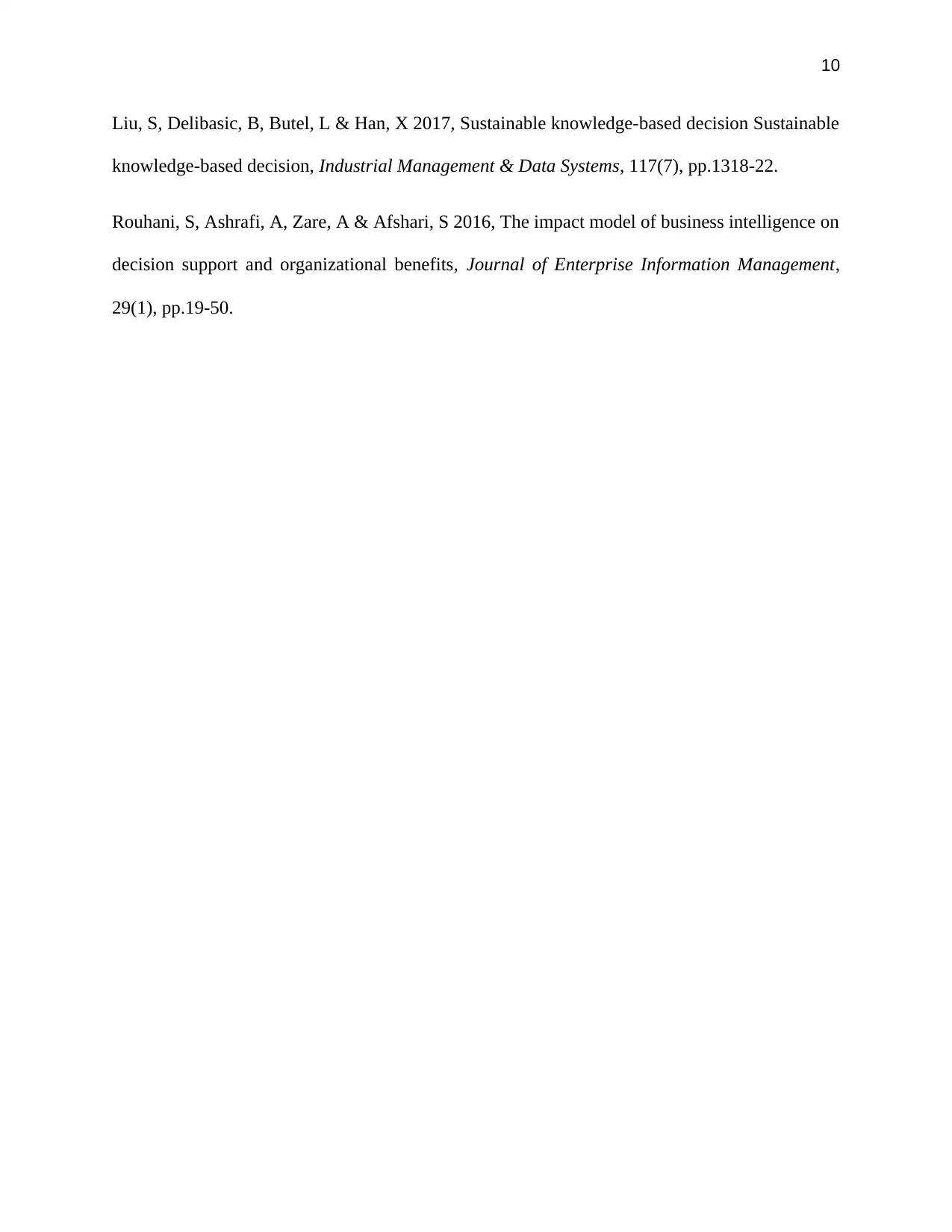
10
Liu, S, Delibasic, B, Butel, L & Han, X 2017, Sustainable knowledge-based decision Sustainable
knowledge-based decision, Industrial Management & Data Systems, 117(7), pp.1318-22.
Rouhani, S, Ashrafi, A, Zare, A & Afshari, S 2016, The impact model of business intelligence on
decision support and organizational benefits, Journal of Enterprise Information Management,
29(1), pp.19-50.
Liu, S, Delibasic, B, Butel, L & Han, X 2017, Sustainable knowledge-based decision Sustainable
knowledge-based decision, Industrial Management & Data Systems, 117(7), pp.1318-22.
Rouhani, S, Ashrafi, A, Zare, A & Afshari, S 2016, The impact model of business intelligence on
decision support and organizational benefits, Journal of Enterprise Information Management,
29(1), pp.19-50.
1 out of 11
Related Documents
Your All-in-One AI-Powered Toolkit for Academic Success.
+13062052269
info@desklib.com
Available 24*7 on WhatsApp / Email
![[object Object]](/_next/static/media/star-bottom.7253800d.svg)
Unlock your academic potential
Copyright © 2020–2025 A2Z Services. All Rights Reserved. Developed and managed by ZUCOL.





